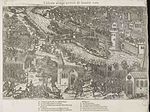Orléans

Orléans (UK: ; US: , French: [ɔʁleɑ̃] ) is a city in north-central France, about 120 kilometres (74 miles) southwest of Paris. It is the prefecture of the department of Loiret and of the region of Centre-Val de Loire. Orléans is located on the river Loire nestled in the heart of the Loire Valley, classified as a World Heritage Site, where the river curves south towards the Massif Central. In 2020, the city had 117,026 inhabitants within its municipal boundaries. Orléans is the center of Orléans Métropole that has a population of 290,346. The larger metropolitan area has a population of 454,208, the 20th largest in France.The city owes its development from antiquity to the commercial exchanges resulting from the river. An important river trade port, it was the headquarters of the community of merchants frequenting the Loire. It was the capital of the Kingdom of France during the Merovingian period and played an important role in the Hundred Years' War, particularly known for the role of Joan of Arc during the siege of Orléans. Every first week of May since 1432, the city pays homage to the "Maid of Orléans" during the Johannic Holidays which has been listed in the inventory of intangible cultural heritage in France. One of Europe's oldest universities was created in 1306 by Pope Clement V and re-founded in 1966 as the University of Orléans, hosting more than 20,000 students in 2019.The Île d'Orléans in Quebec, Canada, takes its name from Orléans, as do Orléans, Ontario and the city of New Orleans, Louisiana.
Excerpt from the Wikipedia article Orléans (License: CC BY-SA 3.0, Authors, Images).Orléans
Rue Fernand Rabier, Orléans
Geographical coordinates (GPS) Address Nearby Places Show on map
Geographical coordinates (GPS)
| Latitude | Longitude |
|---|---|
| N 47.9025 ° | E 1.909 ° |
Address
Rue Fernand Rabier 1
45000 Orléans
Centre-Val de Loire, France
Open on Google Maps








